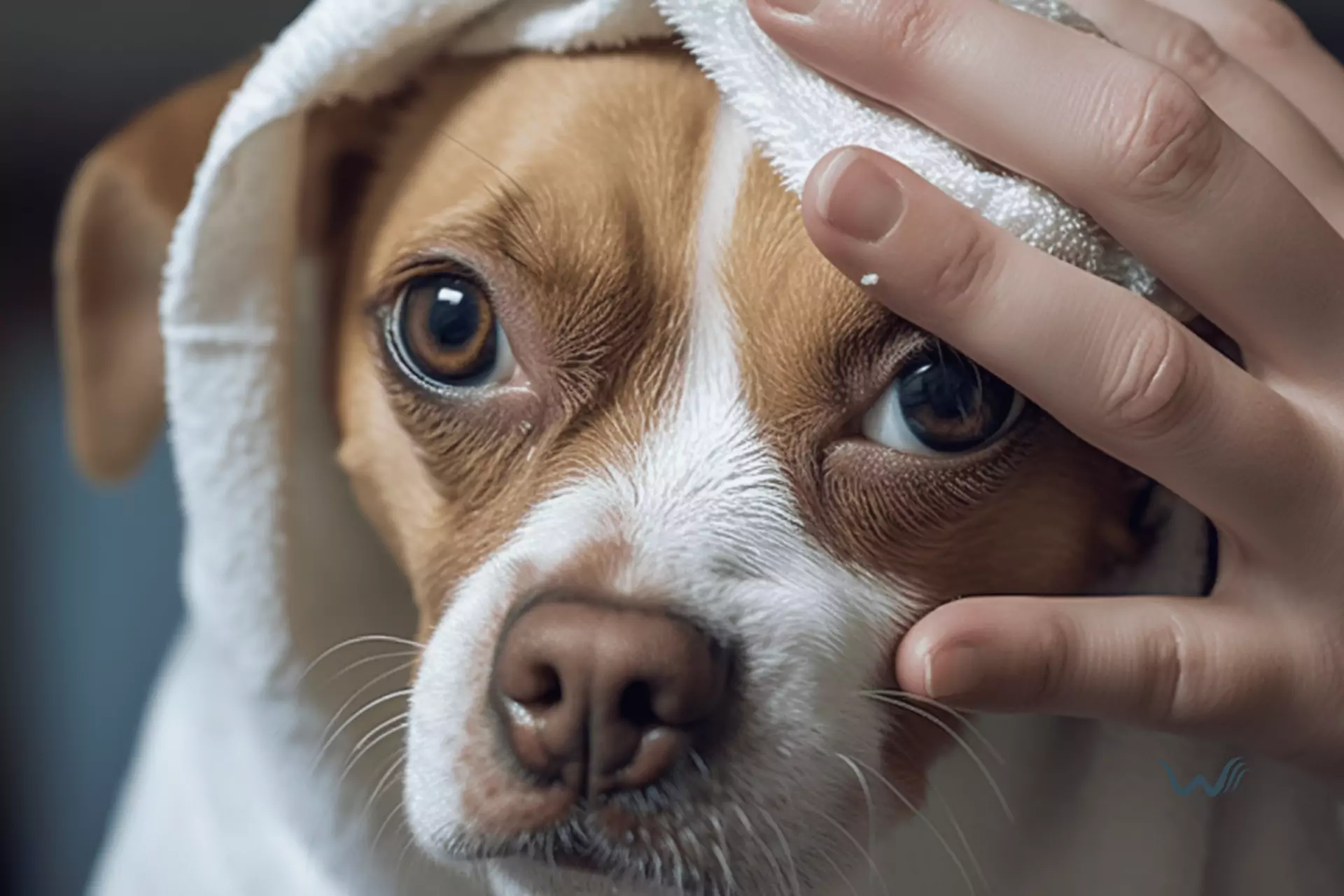

How To Treat Pink Eye In Dogs
by Haley Mills
Last updated: January 30, 2024
Verified and Approved by:
Angela Morris,
MSW, LCSW
Fact Checked

Pink eye, also known as conjunctivitis, is a common eye infection in dogs that can cause discomfort and irritation. Just like humans, dogs can experience redness, swelling, and discharge in their eyes when they have pink eye. If your furry friend is suffering from this condition, you’ll need to know how to treat it effectively. This article will guide you through the process of recognizing the symptoms, consulting a veterinarian for diagnosis and treatment, administering medication, practicing good hygiene, and monitoring the recovery process to ensure your dog’s eyes are back to their healthy state in no time.
When it comes to treating pink eye in dogs, the first step is recognizing the symptoms. Keep an eye out for redness, swelling, discharge, and excessive blinking in your dog’s eyes. If you notice any of these signs, it’s crucial to consult a veterinarian for a proper diagnosis and treatment plan. They can assess the infection’s severity and prescribe the appropriate medication to alleviate your dog’s discomfort. With the right treatment and care, your furry companion will return to their playful self in no time.
Recognizing the Symptoms of Pink Eye in Dogs
Now that you understand the basics of pink eye in dogs, let’s dive deeper into recognizing the symptoms so you can take prompt action. Pink eye, also known as conjunctivitis, is an inflammation of the conjunctiva, the thin tissue covering the eye’s white part. One of the most common symptoms of pink eye in dogs is redness in the affected eye. The whites of the eye may appear pink or even bloodshot. You may also notice swelling and discharge from the eye. The discharge can range from clear and watery to thick and yellow or green in color. Additionally, dogs with pink eye may experience excessive blinking or squinting and rubbing or pawing at their eyes.
Another symptom to look out for is excessive tearing or watery eyes. Dogs with pink eye may have tear stains on their fur, especially around the affected eye. It’s important to note that these symptoms can also indicate other eye conditions, so it’s best to consult a veterinarian for an accurate diagnosis. Additionally, if your dog is showing signs of discomfort or pain, such as rubbing their eye or avoiding light, it’s crucial to seek veterinary attention as soon as possible. Prompt treatment can help alleviate your dog’s discomfort and prevent the infection from spreading to other dogs or even humans.
Consulting a Veterinarian for Diagnosis and Treatment
If your furry friend is experiencing any symptoms of pink eye, you must schedule a consultation with a veterinarian for proper diagnosis and treatment. While some cases of pink eye may resolve on their own, it is still crucial to have a professional evaluate your dog’s condition to rule out any underlying causes or potential complications. A veterinarian will be able to thoroughly examine your dog’s eyes, checking for any signs of infection or inflammation. They may also conduct tests, such as a tear film evaluation or a culture of the eye discharge, to determine the specific cause of the pink eye. Once a diagnosis is made, the veterinarian will recommend the appropriate treatment plan for your dog’s condition.
Treatment for pink eye in dogs typically involves a combination of medication and supportive care. The veterinarian may prescribe antibiotic eye drops or ointment to help clear the infection and reduce inflammation. Be sure to follow the veterinarian’s instructions for administering the medication and any recommended dosage or frequency. In addition to medication, the veterinarian may also recommend warm compresses or gentle eye cleaning to help soothe your dog’s eyes and remove any discharge. They may also guide how to prevent the spread of pink eye to other pets or humans in the household. By consulting a veterinarian, you can ensure that your dog receives the appropriate treatment and care for their pink eye, helping them recover quickly and comfortably.
Administering Medication for Pink Eye in Dogs
First, make sure you’re properly administering the medication to your furry friend’s pink eye. Your veterinarian will provide you with specific instructions on how to apply the medication, including the dosage and frequency. It’s a good idea to follow these instructions carefully to ensure that your dog receives the proper treatment.
When administering the medication, it’s crucial to wash your hands thoroughly before and after handling the medication to prevent the spread of infection. Use a clean cotton ball or sterile gauze pad to apply the medication to your dog’s eye. Gently hold your dog’s head still and carefully open the eyelid to expose the affected eye. Apply the medication as directed by your veterinarian, being careful not to touch the tip of the medication bottle to your dog’s eye to avoid contamination. After administering the medication, give your dog a treat or praise to reward them for their cooperation.
It’s important to continue administering the medication for the full prescribed duration, even if your dog’s symptoms improve. Stopping treatment too soon can lead to a recurrence of the infection. If you have any questions or concerns about administering the medication, don’t hesitate to contact your veterinarian for guidance. They can provide you with further instructions or address any concerns you may have. By adequately administering the medication, you can help your furry friend recover from pink eye and prevent further complications.
Practicing Good Hygiene to Prevent the Spread of Pink Eye
To prevent the spread of pink eye in dogs, make sure you regularly clean their bedding and toys. Pink eye is highly contagious and can easily spread from one dog to another through contact with contaminated surfaces. Keeping your dog’s bedding and toys clean can minimize the risk of spreading the infection.
Start by washing your dog’s bedding at least once a week. Use hot water and a pet-friendly detergent to kill any bacteria or viruses that may be present. Make sure to dry the bedding thoroughly before allowing your dog to use it again. Additionally, regularly clean your dog’s toys with pet-safe disinfectants or by washing them in hot, soapy water. This will help remove any potential contaminants and reduce the risk of reinfection.
In addition to cleaning their bedding and toys, it is also important to practice good hygiene when handling your dog. Wash your hands thoroughly with soap and water before and after interacting with your dog, especially if they have pink eye. Avoid touching your face or eyes after handling your dog; this can transfer bacteria or viruses. By practicing good hygiene and keeping your dog’s environment clean, you can help prevent the spread of pink eye and protect your furry friend’s health.
Can the Same Treatment for Blisters on Dog and Cat Paws Be Used for Pink Eye in Dogs?
When it comes to treating blisters on paws, it’s important to consult a vet for proper care. However, the same approach does not apply to pink eye in dogs. Pink eye requires specific veterinary diagnosis and treatment, so it’s crucial to seek professional guidance for your pet’s health needs.
Can the same treatment be used for both pink eye and a scab on a dog?
Yes, the best way to treat a scab on a dog is by keeping it clean and applying a pet-safe antibiotic ointment. However, it is not the same treatment for pink eye in dogs. Pink eye requires veterinary evaluation for proper diagnosis and treatment, which may involve medication or other interventions.
Can the Treatment for Lice on Dogs Be Used for Pink Eye in Dogs?
Yes, the treatment for getting rid of lice on dogs can also be effective for pink eye in dogs. Certain medications and soothing eye drops can be used to treat both conditions. It is important to consult with a veterinarian to determine the best course of action for your dog’s specific needs.
Monitoring and Managing the Recovery Process
Make sure you closely monitor your pup’s progress and manage their recovery process accordingly. Pink eye in dogs can take some time to fully heal, so monitoring their symptoms and adjusting their treatment plan is the best idea. During the recovery process, continue to keep your dog’s eyes clean by gently wiping away any discharge with a clean, damp cloth. Be sure to wash your hands thoroughly before and after handling your dog’s eyes to prevent the spread of infection.
In addition to keeping the eyes clean, it’s also essential to follow any medication instructions given by your veterinarian. If your dog has been prescribed eye drops or ointment, administer them as directed and complete the full course of treatment. Even if your dog’s symptoms improve, continue the medication for the prescribed duration to ensure that the infection is fully cleared.
During recovery, it’s also a good idea to limit your dog’s exposure to potential irritants or allergens that may worsen their symptoms. This can include keeping them away from dusty or smoky environments, avoiding exposure to strong chemicals or cleaning agents, and ensuring their bedding and living areas are clean and free of potential allergens. By closely monitoring your dog’s progress and managing their recovery process, you can help ensure a speedy and successful recovery from pink eye.
Frequently Asked Questions
Can pink eye in dogs be transmitted to humans?
Yes, pink eye in dogs can be transmitted to humans. A bacterial or viral infection causes it and can spread through direct contact. It is important to practice good hygiene to prevent transmission.
Is there a specific breed or age group of dogs that are more susceptible to pink eye?
There is no specific breed or age group of dogs that are more susceptible to pink eye. It can affect any dog, regardless of breed or age.
Are there any home remedies that can be used to treat pink eye in dogs?
There are no proven home remedies for treating pink eye in dogs. It is important to consult a veterinarian for proper diagnosis and treatment, as they can prescribe medication or recommend appropriate care.
How long does it usually take for a dog to recover from pink eye?
The recovery time for dogs with pink eye can vary, but it usually takes around 1 to 2 weeks for them to recover with proper treatment and care fully.
Can pink eye in dogs cause long-term damage to their vision?
Pink eye in dogs can cause long-term damage to their vision if left untreated. It is important to consult a veterinarian for proper diagnosis and treatment to avoid any potential complications and ensure the dog’s eye health.
Certify Your Emotional Support Animal Today

Why You Can Rely on Us?
At Wellness Wag, we believe your pet deserves care rooted in both science and compassion. Each article is carefully researched, written in clear language for pet owners, and then reviewed by qualified professionals to ensure the information is evidence-based, current, and practical for real-life care. Our goal is to help you feel confident in making informed decisions about your pet’s health and well-being.
Reviewed by
Angela Morris, MSW, LCSW
Angela is a licensed clinical social worker with 20 years of experience in patient advocacy and community mental health. She has assisted numerous clients with ESA evaluations and brings a deep understanding of disability accommodations, ensuring that all information is accurate, supportive, and practical.

Written by :
Haley Mills
Last Updated :
January 30, 2024











